 |
 |
 |
|
 |
| |
|
Venus
transit observation of June 8, 2004
The morning of June 8, 2004 ...
02h53m local time : I
receive an email message announcing the shipment of
a Celestron C14 optical tube assembly to my
observatory. This is a long awaited message, that
(almost) concludes a one year process of preparing
the set up a second telescope at CBA Belgium
Observatory.
02h59m local time : I
conclude a time-series CCD photometry session on V380
Oph, a prime target of the CBA. A couple
of minutes later, my telescope slews to LL And,
another great target of opportunity for photometry,
last seen in outburst in 1993. Twilight is
approaching, but the importance of this outburst
makes the short session worthwhile. And with some
luck, professional astronomers at MDM Observatory
will be able to take over some time after my session
concludes, using a 1.3-m telescope.
07h00m local time : I
remove the CCD camera from the telescope, attach a
Baader Solar filter to the front of the telescope,
and instruct TheSky to slew it to the Sun. A minute
later, I'm looking at a stable image of the Sun. Sky
conditions are perfect - not a single cloud-, and the temperature is
rising steadily. It's gonna become the warmest day
of this year, with a temperature of about 31 degrees. I trust the forecast.
Life of an amateur
astronomer can be exciting, isn't it ?
The Venus transit - ingress
I started my Venus observing session around 5h UT, about 20 minutes
before the start of the transit. Around 5h20m UT,
first contact (ingress) was seen, and a few minutes
later, the transit became really easy to spot in the
telescope (also for less experienced observers). I
connected my Olympus C3030 Zoom digital camera to
the telescope, using a Digi-T Kit connector,
and started making first images.
|
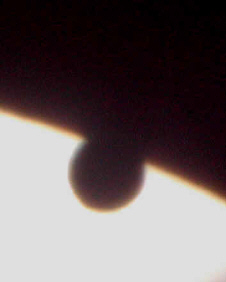 |
|
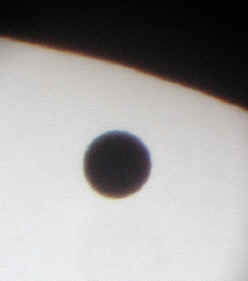 |
| Images made with an Olympus C3030 Zoom
digital camera, attached to a 0.35-m f/6.3
telescope (effectively reduced to 0.08-m). The
image at left was obtained on 2004, June 8.23
UT, during ingress. The one at right shows Venus during transit. (c) Tonny Vanmunster |
| Around 5h40m UT,
Venus' silhouette became detached from the Sun's
limb. I visually looked for the famous "black-drop
effect", but could not see it in my 0.35-m
f/6.3 telescope (aperture reduced to 8 cm). However,
shortly before the very black disk of Venus
completely slided
into the Sun's bright edge, it grew a small, easy to
spot halo (aureole) of light around its dark edge.
The halo lasted a few minutes and then vanished. I
realised I was looking at Venus' atmosphere.
Actually, the aureole is caused by sunlight passing
through the planet's dense atmosphere. This was a
beautiful, and unexpected phenomenon. Shortly after,
I saw numerous reports on a mailing list of the
Flemish Astronomical Association VVS, also
mentioning the halo observations. |
|
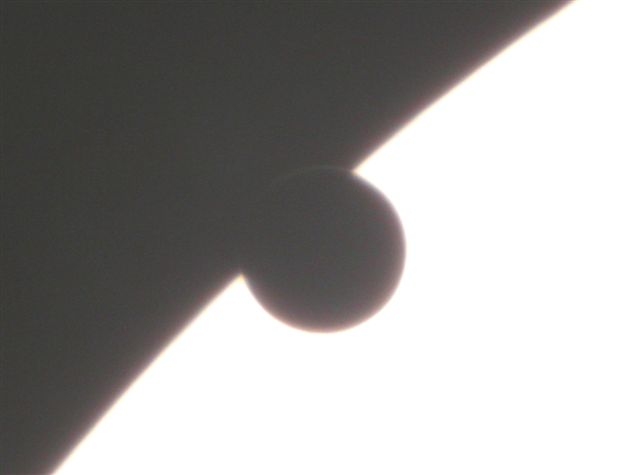 |
|
|
Venus'
atmosphere is easily visible in this image
made by Jan Koeman, Stichting
Volkssterrenwacht Philippus Lansbergen, The
Netherlands. |
Visitors at CBA
Belgium Observatory
Venus' transit would
last for >6 hours in Belgium, so there was plenty
of time to share the event with others. I hosted the
local school (Gemeentelijke Basisschool Walshoutem),
where both of my sons stay, for an observing
session. It turned out to be a great experience :
the children first got some information about the
Solar system (relative sizes and distances of the
inner planets), and then observed Venus with special
eclipse glasses. Highlight of course was a visit to
the observatory, where they could visually spot the
dark disk of Venus through the telescope.
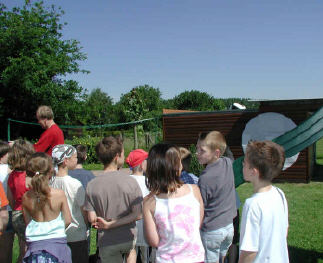 |
|
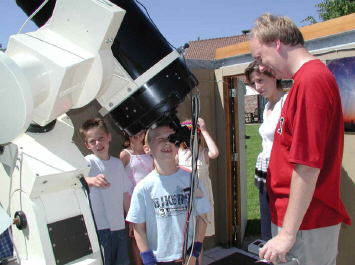 |
|
| A
small model of the Solar System was built (the
Sun's model disk is seen on the outside wall
of the observatory) to demonstrate relative
sizes and distances to the school children. |
|
Being
able to see Venus through a real telescope
definitely was the most impressive part of the
visit. |
|
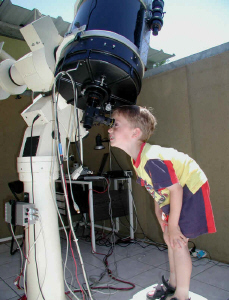 |
|
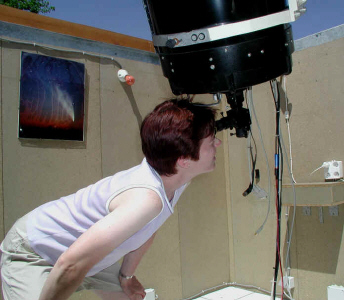 |
|
|
|
|
|
Egress - timings,
black-drop effect, atmosphere
Around 11h04m UT,
Venus' silhouette reached the Sun's limb for its
final egress. This time, I decided to make digital
images of the approach. Much to my surprise, the
black-drop effect appeared on the images, while I
hadn't seen it visually during ingress. In my
opinion, this once more proofs that the effect is
mainly due to contrast aspects and Earth's
atmospheric conditions (which were much better at
ingress).
|
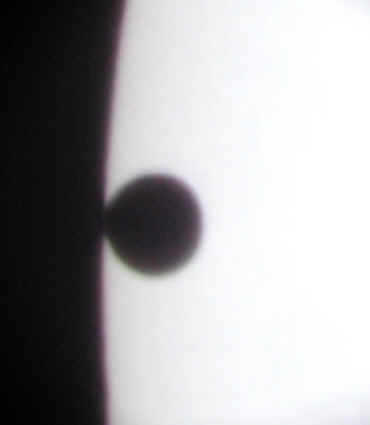 |
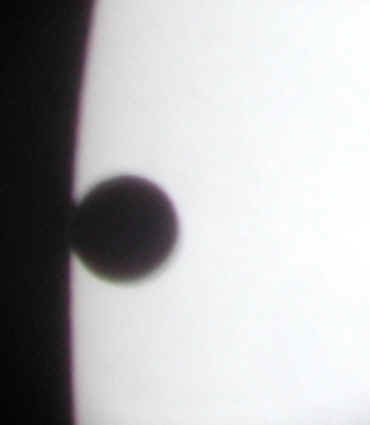 |
The
black drop effect becomes visible just before
the start of third contact. 0.35-m f/6.3
telescope (effective aperture 8-cm) and
Olympus C-3030Z camera. Tonny Vanmunster. |
|
|
|
|
Shortly
after the start of egress, I switched back to visual
observing, and immediately noticed Venus' atmosphere
again. My wife Kathleen also easily spotted it,
although I didn't mention where to look. Again, the
halo disappeared after a few minutes, shortly before
half of Venus' disk had left the Sun's limb.
I
concluded the transit observation by trying to make
an accurate timing of fourth contact. I found a
value of 11h23m20s UT.
Future Venus
transits
The next Venus
transit occurs on June 6th, 2012 and only the final
part will be visible from Belgium. After that,
one has to 'wait' till 2117 for a next transit. I
came across following quote from William Harkness,
Director of the U.S. Naval Observatory in 1882, at
the moment of the previous Venus transit.
"We are now
on the eve of the second transit of a pair, after
which there will be no other till the twenty-first
century of our era has dawned upon the earth, and
the June flowers are blooming in 2004. When the last
transit season occurred the intellectual world was
awakening from the slumber of ages, and that
wondrous scientific activity which has led to our
present advanced knowledge was just beginning. What
will be the state of science when the next transit
season arrives God only knows. Not even our
children's children will live to take part in the
astronomy of that day. As for ourselves, we have to
do with the present ..."
What will be the
state of science in 2117 ? God only knows ...
|
|
|
 |
|
 |
|
|
 |
Copyright © 2004 - Tonny Vanmunster.
|
 |
|
 |